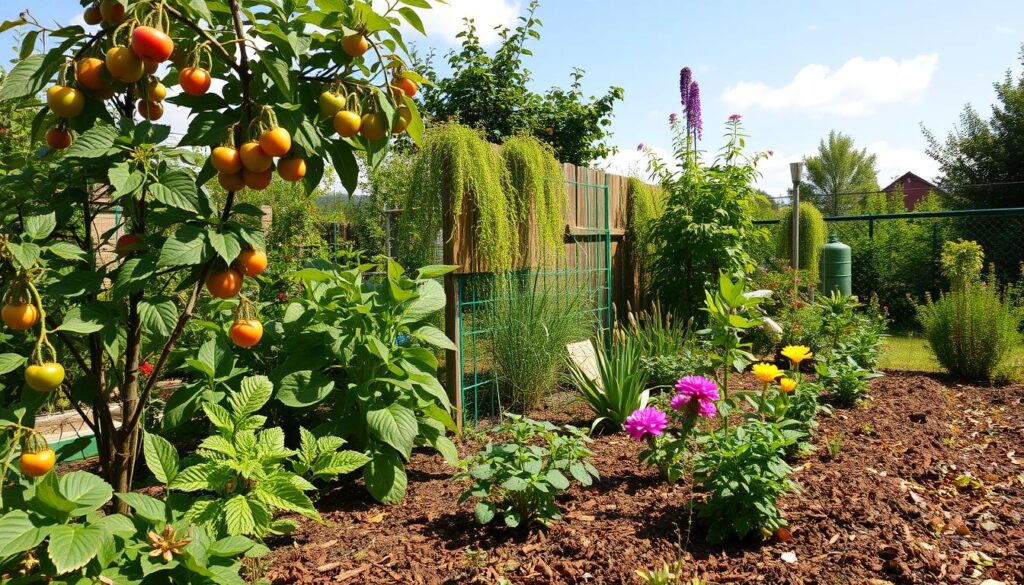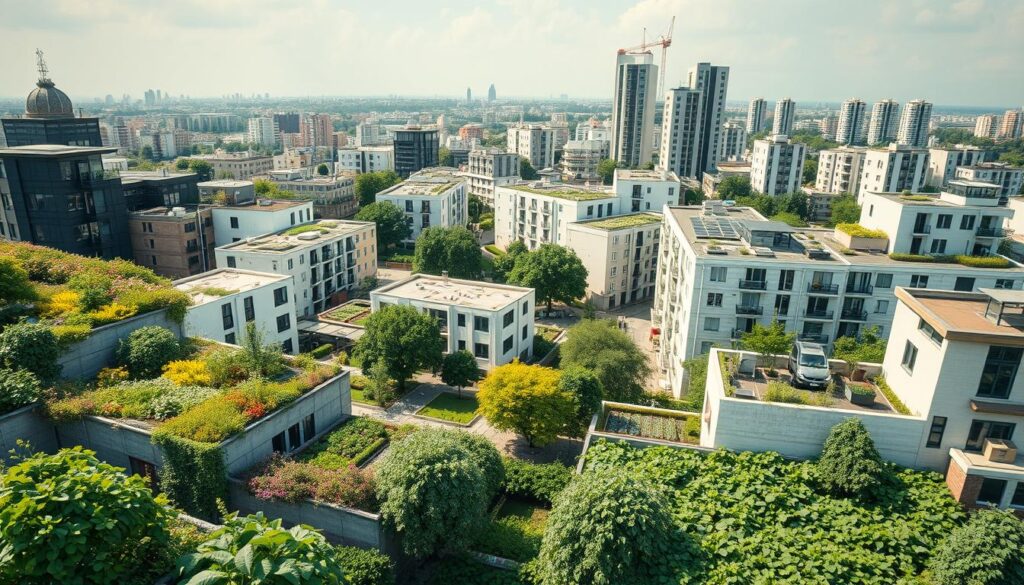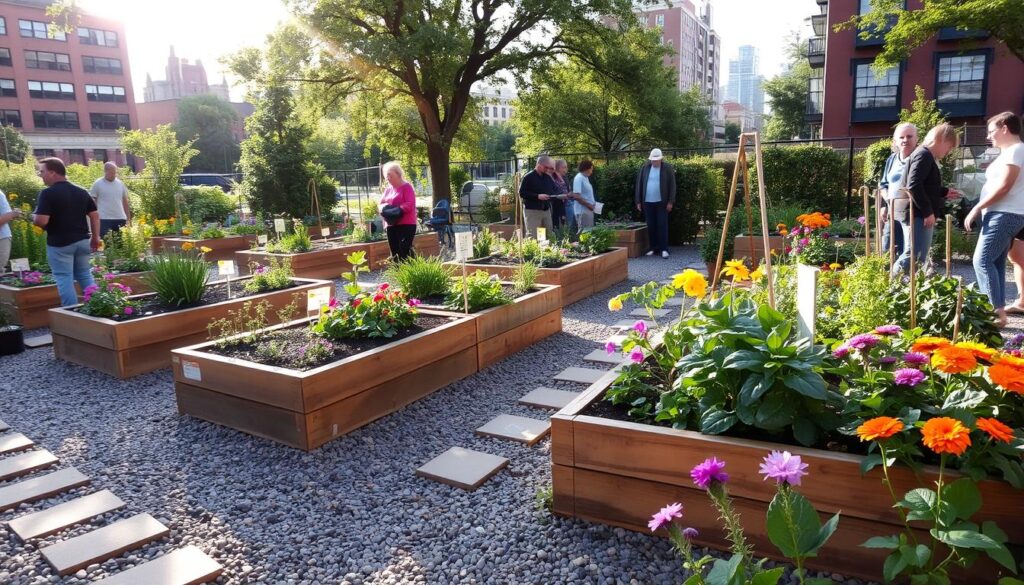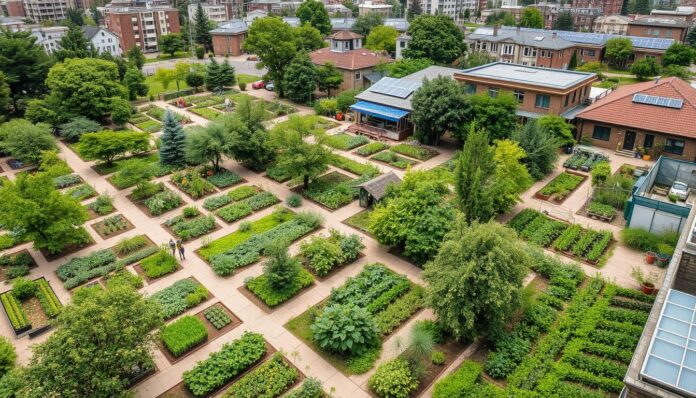Permaculture neighborhood planning is key for a sustainable community design. The United States Department of Agriculture (USDA) has put about $11.5 million into urban agriculture. This money went to composting and food waste reduction projects in 23 states. It shows how important permaculture is in cities, helping with food security and climate change.
Permaculture planning makes urban areas more like nature. This approach helps create strong, self-sufficient ecosystems. It reduces the need for outside help and cuts down on waste. By using permaculture, cities can design better for both the planet and people. The USDA’s support for urban farming shows permaculture’s power to change city food systems.
Permaculture planning also tackles health issues related to food and farming. For instance, the USDA’s funding can make more healthy food available. This can lower obesity and chronic diseases. By using permaculture, cities can support healthier living and ease the load on healthcare.
Key Takeaways
- Permaculture neighborhood planning is essential for creating sustainable community design.
- The USDA has invested approximately $11.5 million in composting and food waste reduction projects across 23 states.
- Permaculture can help address challenges such as food insecurity and climate change in urban settings.
- Permaculture neighborhood planning involves designing sustainable community systems that mimic nature.
- The USDA’s investment in urban agriculture and innovative production efforts demonstrates the potential for permaculture to transform urban food systems.
- Permaculture can help address public health concerns linked to food insecurity and agricultural practices.
Understanding Permaculture in Urban Settings
Permaculture is a way to design and manage spaces in a holistic way. It works on small scales like gardens and big scales like neighborhoods. In cities, you don’t need a lot of land to practice permaculture. This makes it easy for anyone to join in.
This approach to regenerative urban development aims to make cities greener and better for everyone. It focuses on creating eco-friendly neighborhood design that helps the environment and the community.
Urban permaculture can be seen in many forms. There are community gardens, food forests, and green roofs. These projects give people fresh food and green spaces. They also bring people together and encourage working together.
By using permaculture, city folks can help make our food system better. They can reduce their need for industrial farming and support local food.
Key Principles of Permaculture
Permaculture is built on three main ideas: earth care, people care, and fair share. These ideas help design and run permaculture systems. They make sure these systems are good for the planet, fair for people, and work well financially.
By following these principles, city residents can build strong ecosystems. These ecosystems support many species, save resources, and improve community health.
Benefits of Permaculture in Urban Environments
Permaculture in cities has many benefits. Some of these include:
- More food and fresh produce for everyone
- Cleaner air and water
- More biodiversity and ecosystem services
- Stronger communities and social bonds
- Less heat in cities and help with climate change
The Role of Urban Agriculture
Urban agriculture is key to making cities sustainable. With over 55% of people living in cities, it’s crucial. Holistic urban planning is needed more than ever. It helps cities use green architecture and cut down on pollution.
Projects like the Beacon Food Forest in Seattle and Incredible Edible Todmorden in the UK are great examples. They turn empty spaces into gardens. These efforts give people fresh food, help local wildlife, and lower carbon emissions.
By using holistic urban planning, cities can become greener and better for everyone. They can add things like solar power, collect rainwater, and recycle waste. This makes cities more eco-friendly and helps us build a better future.
Designing a Permaculture Garden
Creating a permaculture garden requires careful planning and observing the site. You need to analyze the land, understand water, light, and air flow. Also, observe the natural patterns of the environment. This way, you can make a sustainable garden that helps with urban sustainability initiatives.
Permaculture design focuses on working with nature, not against it. You choose the right plants for your site. Use companion planting strategies to make the most of space and reduce pests and diseases. For instance, marigolds with tomatoes can fight nematodes, and beans with corn can shade and improve soil.
Site Analysis and Design Principles
Site analysis is key in permaculture design. It helps identify the site’s unique features and the best design principles. You observe the land’s slope, sunlight direction, and water flow. This knowledge lets you design a garden that meets the site’s specific needs.

Choosing the Right Plants
Choosing the right plants is crucial in permaculture design. It ensures your garden is productive, diverse, and resilient. Pick plants that fit the climate, soil, and moisture of your site. Also, choose plants that offer various benefits, like food, shelter, and wildlife habitat. By using sustainable permaculture practices, you create a garden that’s not just beautiful but also functional and sustainable.
Soil Health and Management
Soil health is key in permaculture neighborhood planning. It affects the community’s sustainability. Healthy soil supports plants, filters water, and stores carbon.
Organic soil amendments and techniques help build soil fertility. This is crucial for permaculture planning. Techniques like crop rotation, cover cropping, and composting are effective.
These methods improve soil structure and nutrient availability. They also support beneficial microorganisms. By using these techniques, communities can focus on soil health in their designs.
Permaculture planning also involves sustainable design principles. These include reducing soil erosion and increasing organic matter. Adopting these principles helps create thriving ecosystems.
These ecosystems support both human and environmental well-being. Here are some key strategies for improving soil health:
| Strategy | Description |
|---|---|
| Crop Rotation | Rotating crops to improve soil fertility and structure |
| Cover Cropping | Planting cover crops to reduce soil erosion and increase soil organic matter |
| Composting | Creating compost to add nutrients and beneficial microorganisms to the soil |
Importance of Healthy Soil
Healthy soil is vital for plant growth, water filtration, and carbon storage. In permaculture planning, it’s essential for sustainable community designs.
Techniques for Building Soil Fertility
Techniques like crop rotation, cover cropping, and composting enhance soil fertility. These methods are part of permaculture planning. They help create ecosystems that support both humans and the environment.
Organic Soil Amendments
Organic amendments, such as compost and manure, add nutrients and microorganisms to soil. They improve soil fertility and structure. This supports plant growth and environmental health.
Water Management in Urban Agriculture
Effective water management is key for green cities and eco-friendly neighborhoods. In urban farming, saving water is very important. Using plants that don’t need much water and smart irrigation systems can cut down water use a lot.
Brad Lancaster’s work in Tucson, Arizona, shows how rainwater harvesting works well. Urban farmers can collect and save rainwater for uses other than drinking. This helps them use less city water.

Water Conservation Techniques
Using greywater systems is a good way to save water. These systems use water from sinks, showers, and washing machines for plants. Mulching and composting also help by keeping water in the soil and making it better for plants.
Rainwater Harvesting Systems
Rainwater harvesting systems have four main parts: the roof, gutters, tanks, and irrigation. These systems are made to fit the needs of city farmers. They provide a steady water source for their crops.
Irrigation Methods in Permaculture
Permaculture uses water wisely and tries to waste as little as possible. Methods like drip irrigation and swales help save water. They also keep the soil healthy and help plants grow well.
Biodiversity in Urban Gardens
Urban gardens are key in boosting biodiversity. This is vital for a healthy city and green neighborhoods. They support a wide variety of plants and animals, helping to increase biodiversity.
The role of different plants in urban gardens is huge. Studies have shown they can boost local biodiversity by up to 30% compared to regular lawns. They offer homes for helpful insects and food for wildlife.
Importance of Plant Diversity
Diverse plants help support about 20% more beneficial insects. These insects are vital for pollination and controlling pests. This makes the urban garden ecosystem healthier and more resilient.
Attracting Pollinators
It’s crucial to attract bees and butterflies in urban gardens. This can be done by adding various flowering plants, like native wildflowers. Such gardens can be home to up to 75% of local pollinators, boosting biodiversity.
By supporting biodiversity in urban gardens, we build sustainable ecosystems. These ecosystems support local wildlife and contribute to a greener city. This has a positive effect on the environment and the community, making urban gardens vital for city growth.
Community Involvement in Urban Agriculture
Community involvement is key in urban agriculture. It brings people together to grow food sustainably. By joining local projects, people help with sustainable permaculture practices and support urban sustainability initiatives. This effort not only gives access to fresh food but also builds community and social bonds.
Some benefits of getting involved in urban agriculture include:
- More food security and fresh produce
- Health benefits from gardening and being outdoors
- Stronger community ties and social connections
- Helping local economies and sustainability efforts
About 27% of urban farmers are Black or Latinx. They work in community gardens and local food systems in neglected areas. This shows how vital community involvement is in urban agriculture, helping to tackle social and economic gaps.

Supporting community gardens and urban agriculture projects helps create a better food system. It’s good for the environment and supports urban sustainability initiatives and sustainable permaculture practices in local areas.
| Benefits of Community Gardens | Percentage of Urban Residents |
|---|---|
| Improved food security | 30% |
| Enhanced community engagement | 65% |
| Support for local economies | 20% |
Urban Agricultural Infrastructure
Creating urban spaces that reduce waste and boost efficiency is key for sustainable community design. This helps in setting up a solid base for urban farming. Important parts of urban farming include greenhouses, community gardens, and vertical farming systems.
For sustainable building, energy-efficient materials and designs are vital. This means using recycled materials, setting up rainwater harvesting systems, and adding renewable energy sources. These steps help in building urban farming systems that support permaculture and sustainable living.
- Access to water and nutrients
- Soil quality and management
- Waste management and recycling
By focusing on these areas, we can create efficient and productive urban farming systems. This supports sustainable community design and permaculture neighborhood planning.
Integrating Technology in Permaculture
The world is getting more urban, making eco-friendly neighborhoods crucial. Technology can help in permaculture, making farming smarter and greener. Apps and smart farming solutions boost efficiency and cut waste, supporting sustainable living.
Technology in permaculture is good for the planet. Studies show homes in permaculture areas cut their environmental impact by half. These areas also see a 30% boost in local wildlife.
Smart Farming Solutions
Smart farming tech helps farmers grow more with less water and waste. It includes sensors for soil and weather, and auto-irrigation. These tools make farming more efficient and green.
Role of Apps and Software in Urban Farming
Apps and software are key for urban farmers. They offer insights and tools for better crop management. Apps track soil and weather, and spot pests, helping farmers make smart choices.
Technology in permaculture can change urban farming. It leads to more efficient, green, and healthy neighborhoods. This improves our environment and quality of life.
Challenges Facing Urban Agriculture
Urban agriculture faces many challenges, like land use and zoning issues. These can be solved with holistic urban planning. This method looks at social, economic, and environmental aspects of city growth. It promotes green neighborhood architecture that blends urban farming into city life.
Getting access to resources like land, water, and money is a big problem. A report from igrownews.com says urban farming can help make fresh, healthy food more available. But, it needs support from local governments and communities.
Some major hurdles for urban agriculture include:
- Land use and zoning issues
- Access to resources, such as water and funding
- High land prices and strict zoning rules
Even with these obstacles, urban farming can improve food and nutrition access. By using holistic urban planning and green neighborhood architecture, cities can build strong, green food systems. These systems help the environment and the community.
Economic Aspects of Urban Agriculture
Urban agriculture can support sustainable permaculture practices and urban sustainability initiatives in many ways. By using permaculture, urban farmers can save money and work more efficiently. This leads to big economic benefits.
Some key economic advantages of urban permaculture are:
- Reduced waste management costs
- Lower energy consumption
- Increased local food production, enhancing social resilience and improving urban aesthetics
Studies show that urban permaculture can cut down carbon emissions a lot. For example, in Melbourne, Australia. It also creates jobs and helps local communities, like the Beacon Food Forest project in Seattle. This project turned a seven-acre plot into a place for community food production.
By supporting urban sustainability initiatives and using sustainable permaculture practices, cities can lessen their environmental impact. This also boosts economic growth and social resilience. As more people move to cities, the role of urban agriculture and permaculture will grow even more.
| City | Urban Agriculture Initiative | Economic Benefit |
|---|---|---|
| Havana, Cuba | Urban fruit and vegetable production | Over 90% of city’s fruit and vegetable consumption produced within city limits |
| Seattle, USA | Beacon Food Forest project | Transformed a seven-acre plot into community food production space |
| Melbourne, Australia | Urban permaculture strategies | Significant reduction in carbon emissions |
Policy and Advocacy for Urban Agriculture
As cities grow, with 70% of people living in them by 2050, we need sustainable community design and permaculture neighborhood planning more than ever. It’s important to know the local rules and push for better ones to support urban farming.
The California Urban Agriculture Incentive Zones Act, passed in 2014, lets counties create special zones for farming on private, unused land. This law helps permaculture neighborhood planning by offering benefits for farmers.
Here are some ways to make a difference:
- Connect with local government and community leaders
- Host events and workshops to teach about urban farming
- Make and use sustainable community design plans that include farming
By supporting urban farming and permaculture neighborhood planning, we can make cities better and improve life for everyone living there.
| City | Urban Agriculture Initiatives |
|---|---|
| Boston | Adopted a zoning policy to permit traditional and rooftop gardening, community gardens, hydro and aquaponics, beekeeping, chicken raising, and farmers’ markets |
| California | Established the Urban Agriculture Incentive Zones Act to provide incentives for landowners to commit their land to agriculture |
Future Trends in Urban Agriculture
Urban agriculture is growing, and we need to look at what’s coming next. A big focus is on making cities greener and more sustainable. This means creating neighborhoods that are good for the planet and for people living there.
Studies show that permaculture is key to urban agriculture’s future. Permaculture is all about making systems that work well together. It helps farmers grow food in a way that’s good for the earth and for the people eating it.
Innovations in Permaculture Design
New ideas in permaculture include vertical farming, hydroponics, and aquaponics. These methods use space wisely, save water, and grow more food. They also let city folks get involved in farming, teaching them about where their food comes from.
The Growing Role of Vertical Farming
Vertical farming is getting more popular in cities. It’s a way to grow lots of food in a small area. This method also cuts down on the need for long trips to get food to market. So, vertical farming is a big part of making cities greener and more sustainable.
| Urban Agriculture Method | Benefits |
|---|---|
| Permaculture Design | Self-sustaining ecosystems, minimized waste, maximized productivity |
| Vertical Farming | Space-efficient, increased crop yields, reduced land use, minimized transportation |
Resources and Education for Practitioners
There are many resources for those wanting to learn about permaculture in cities.
Check out books like “The Vegetable Gardener’s Bible” by Edward C. Smith and “The Backyard Homestead” by Carleen Madigan. They explore urban agriculture deeply. Online courses, such as those by Verge Permaculture, offer detailed lessons on permaculture and farming. These courses have over 15,000 students from more than 30 countries.
They cover topics from urban planning to green architecture. This education is key for those interested in sustainable living.
Also, join local permaculture and urban agriculture groups. Look for organizations like the Permaculture News or the Urban Agriculture Network. They offer chances to meet others, attend workshops, and help in community gardens.
By connecting with these groups, you can learn from others and help grow the movement of sustainable living.

